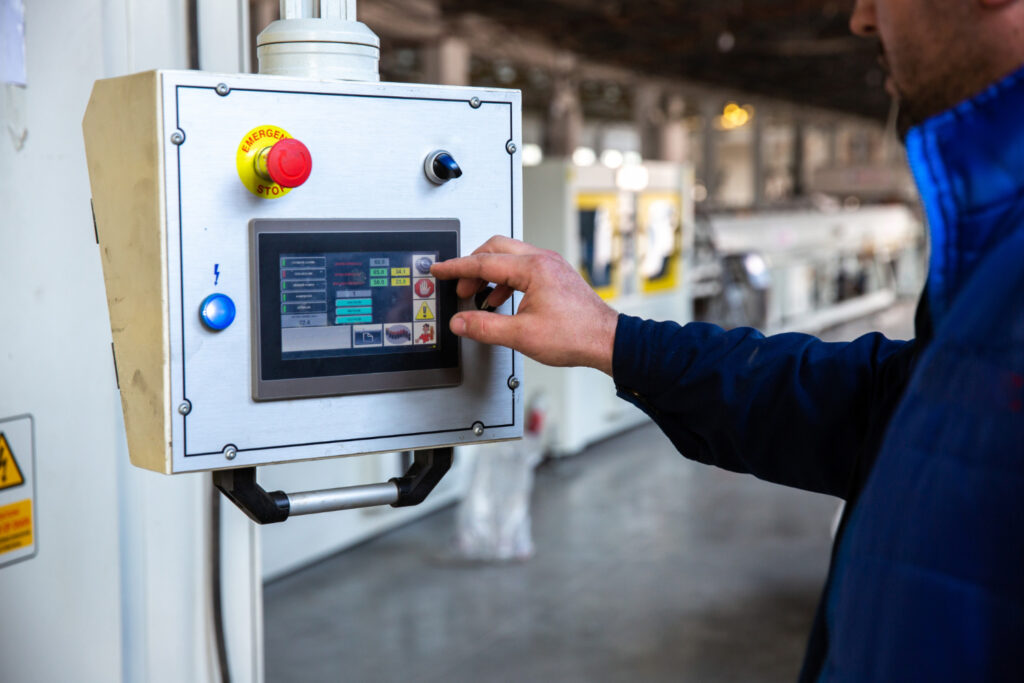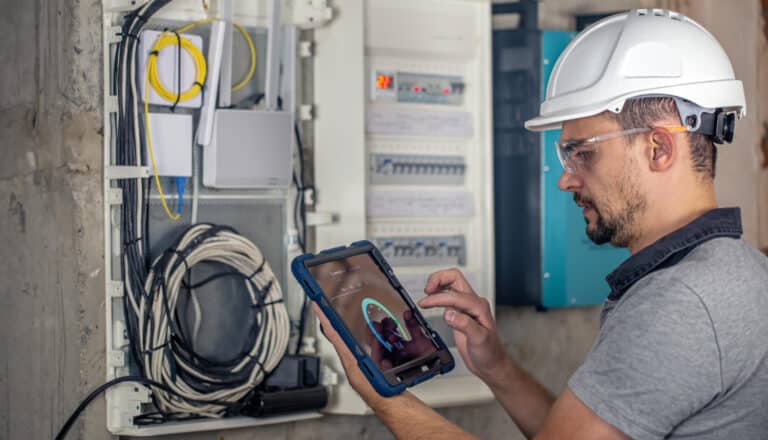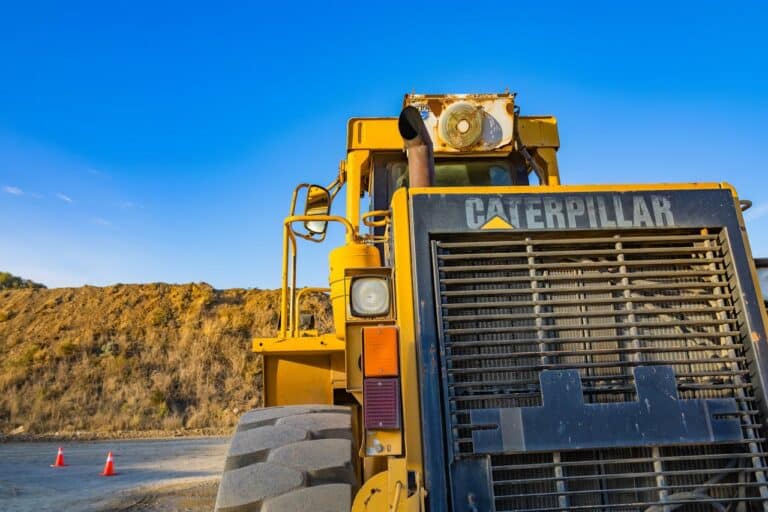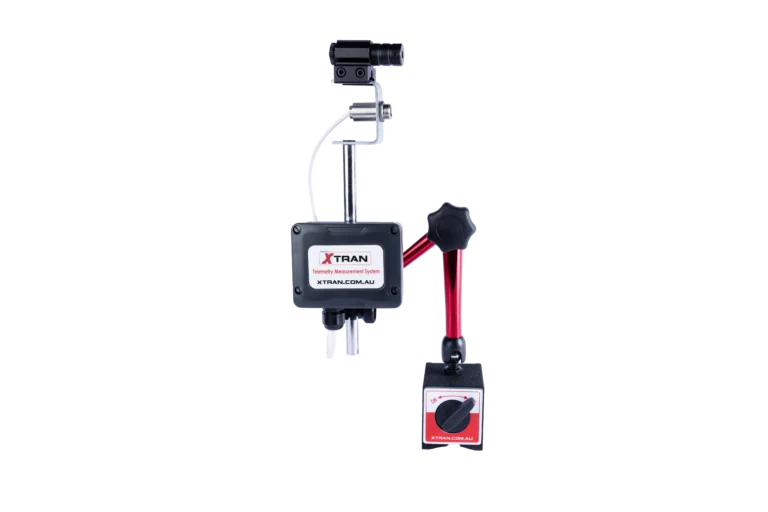Monday - Thursday 9AM - 5PM | Friday 9AM - 4PM
How to Choose the Right Sensor for Your Industrial Application

The wrong sensor causes scrap, nuisance trips, or worst unsafe conditions. The right one reads reliably in your environment, speaks your control team’s “language,” and pays for itself in uptime. Use this guide to move from “what do we measure?” to an informed, defensible choice.
Start with the job to be done
What are you measuring?
Presence/position, distance, temperature, pressure, flow, level, vibration, gas, vision/inspection, or part ID (barcode/QR/OCR). Write it down in one line: “Detect clear PET bottle at 0.6 m on a wet conveyor moving 200 ppm.”
Target & mechanics
- Material: metal, non-metal, liquid, powder, clear/colored, reflective/absorptive.
- Size & shape: smallest feature you must detect or measure.
- Motion: speed, acceleration, run/stop frequency, vibration.
Range, resolution, and allowable error
- Range: expected min–max.
- Resolution: smallest change that matters (e.g., 0.1 mm, 0.01 bar).
- Tolerance: what your process can actually accept repeatability often beats headline accuracy.
Quick chooser (task to sensor type)
| Task / Scenario | Recommended sensor types | Typical range | Strengths | Watch-outs |
| Detect metal part presence | Inductive proximity | 1–20 mm | Rugged, immune to oil/coolant | Short range; metal only |
| Detect non-metal/packaging | Photoelectric (through-beam, retro, diffuse), Laser ToF | 0.05–6 m | Fast, compact, cheap | Clear/reflective targets need the right mode |
| Distance/position on fast line | Laser triangulation, Laser ToF | 10 mm–10 m | High speed, high resolution | Reflectivity & angle matter |
| Level in tank (non-contact) | Ultrasonic, Radar/FMCW | 0.3–30 m | Handles foams (radar), harsh media | Vapors/condensation can affect ultrasonic |
| Pressure (gases/liquids) | Gauge/absolute/differential pressure | Vacuum–1,000+ bar | Mature, many process fittings | Temp effects, need isolation for corrosives |
| Temperature | RTD (Pt100/Pt1000), Thermocouple | −200 to 1,200 °C | RTD = stable/accurate; TC = wide range | Wiring/lead compensation |
| Flow | Magnetic, Coriolis, Vortex, DP | 0.1–10,000 m³/h | Select by fluid conductivity & accuracy need | Install straight-run, density effects |
| Vibration/condition | Accelerometers, IEPE/4–20 mA | Hz–kHz | Early fault detection | Mounting quality drives signal |
| ID/inspection | 2D/3D vision, barcode imager, color/OCR | Line speed bound | Finds small defects, reads codes | Lighting, lensing, glare |
If it moves fast, prefer optical/laser. If it’s harsh or opaque, consider radar/ultrasonic. For metals, inductive beats photoelectric for robustness.
Check the environment & compliance
- Ingress protection
- IP67 = dust-tight + immersion to 1 m for 30 min.
- IP69K = high-pressure, high-temperature washdown (typical in food/CIP).
Choose housings/seals that tolerate your cleaners, oils, or solvents.
- Temperature & shock: Confirm operating range and test standards (e.g., IEC 60068).
- EMC/EMI: Look for industrial immunity (EN 61326-1 or similar). Use shielded cable where noise is ugly (VFDs, welders).
- Hazardous areas: ATEX/IECEx (Zones) or NEC/CEC Class/Division. Decide intrinsically safe vs explosion-proof vs non-incendive.
- Materials & chemicals: 316L stainless, PVDF, FKM/EPDM/PTFE seals match to media and cleaning chemicals.
Nail the performance specs
- Accuracy is closeness to true; repeatability is same-reading, same-conditions. Many processes value repeatability more.
- One bad spec can dominate your error budget.
- Fast presses/conveyors may need ≤5 ms response and kHz sampling.
- Plan recalibration intervals; consider devices with built-in temperature compensation and diagnostics.
Outputs & connectivity (integration that just works)
- Discrete I/O: PNP (sourcing) and NPN (sinking) match your PLC input cards.
- Analog: 4–20 mA (long runs, noise-resistant, loop-powered) vs 0–10 V (short runs, watch drop/noise).
- Smart comms: IO-Link (parameterisation & diagnostics), plus Modbus, EtherNet/IP, PROFINET, OPC UA for plant-level data.
- Wireless (when justified): BLE/Wi-Fi/LoRaWAN for hard-to-reach points; check latency, power, and RF environment.
- Power & connectors: M8/M12, cable exit direction, cordset availability, and gland sealing.
Form factor, mounting & maintenance
- Clearance and blind zones (ultrasonic/radar).
- Bracketry that resists vibration and preserves alignment.
- Quick-disconnects for fast swap-outs.
- Access for cleaning, labeling, and calibration without removing guards.
Safety & functional safety
- If a bad reading can put people or assets at risk, look for safety-rated devices and declare a SIL (IEC 61508) or PL (ISO 13849) target.
- Consider diagnostics coverage, fault detection, and what the safe state is on error (e.g., de-energise to stop motion).
- For guards and presence detection, safety light curtains, interlocks, or safety encoders may be required.
Decision matrix
| Task | Environment | Range/Resolution | Speed/Response | Output/Comms | Approvals | TCO notes | Shortlist |
| Detect clear bottle | Wet, washdown | 0.6 m / 5 mm | 200 ppm / ≤2 ms | PNP + IO-Link | IP69K | Common cordsets | Retro-reflective with polarized filter; laser ToF backup |
| High-temp process | 350 °C oven | −50–500 °C / 0.5 °C | Slow / 100 ms | 4–20 mA | CE | Spare probe kit | Thermocouple w/ mineral-insulated sheath; head-mount transmitter |
| Corrosive tank level | HCl vapors | 0–6 m / 5 mm | Slow / 250 ms | 4–20 mA + HART | ATEX Zone 2 | Remote seals | 80 GHz radar, PTFE antenna; non-contact preferred |
Industrial Sensor Case Studies
Packaging line stopping double-feeds
A snack plant kept jamming a cartoner. Photoeyes missed glossy cartons at speed, causing doubles. The team swapped to a laser time-of-flight sensor with a tighter spot and faster response (<2 ms). They added IO-Link to pull signal quality and distance diagnostics into the PLC. Result: jams dropped 92% over 60 days, operators gained a live “confidence” readout, and maintenance standardised on one cordset across three machines.
Dairy washdown false trips cured
In a CIP area, standard photoelectric sensors are false-tripped during foam cycles. The fix combined IP69K inductive sensors for metal targets and polarised retroreflective photoeyes with chemically resistant housings for non-metal detection. Shielded M12 cabling and proper drain/ground eliminated noise from nearby VFDs. Unplanned stops fell from weekly to near-zero, and replacement time shrank thanks to quick-disconnects.
Oil & gas skid corrosives under control
A chemical injection skid needed differential pressure on a caustic stream. A DP transmitter with remote diaphragm seals and PTFE-lined capillaries kept the sensor out of harm’s way. Adding a head-mount 4–20 mA/HART transmitter provided trimming and device health. With the right wetted materials and Zone-rated enclosure, mean time between failures extended beyond two years.
Common mistakes to avoid
- Ordering NPN when your PLC expects PNP, or vice-versa.
- Chasing lab-grade accuracy when repeatability is what stabilises the process.
- Ignoring cable length, shielding, and grounding near noisy drives.
- Forgetting hazardous-area approvals or washdown requirements.
- Mounting where cleaning knocks alignment out every shift.
Commissioning checklist
- Verify sensing range, orientation, and blind zones.
- Set teach-in/thresholds and debounce/filters.
- Scale 4–20 mA / 0–10 V correctly in the PLC/SCADA.
- Confirm PNP/NPN polarity and input type.
- Ground shields at one end only; route away from VFD cables.
- Map I/O, alarms, and quality/status bits (e.g., IO-Link).
- Capture baseline readings and apply calibration labels with next-due date.
FAQs on Choosing the Right Industrial Sensor
Accuracy is closeness to the true value; repeatability is how tightly readings cluster under the same conditions. Many control loops care more about repeatability because it stabilises setpoints.
Use 4–20 mA for long runs and noisy environments; the current loop resists voltage drop and noise. Use 0–10 V for short, clean runs or when your hardware only supports voltage inputs.
Yes, with the right mode: polarised retroreflective with a proper reflector, or a coaxial laser/through-beam setup. For tough glare or condensation, consider laser ToF or background-suppression models.
IP67 handles brief immersion; IP69K is designed for high-pressure, high-temperature washdown common in food and beverage.
Base it on drift spec, criticality, and history. A common starting point is 6–12 months, extended if stability proves solid.
Only if it’s part of a safety function where failure could harm people or major assets. Your risk assessment will set SIL/PL targets.
Inductive detects metal (robust, reliable). Capacitive detects non-metals like plastics, powders, and liquids but can be more sensitive to buildup and environment.
Often yes parameter storage, remote teach, and diagnostics cut downtime and standardise setups. Hardware price is small versus the time saved.
Industrial Sensor & Controls Glossary
| Term | Definition |
| Accuracy | Closeness to true value. |
| Repeatability | Spread of readings under the same conditions. |
| Hysteresis | Difference between up/down readings at the same point. |
| Response time | How fast the output reflects change. |
| Drift | Slow change of output with no change in input. |
| IP rating | Dust/water ingress protection level. |
| SIL/PL | Safety integrity levels per IEC/ISO standards. |
| Intrinsically safe | Limits energy so a spark can’t ignite. |
| PNP/NPN | Output transistor type; match to PLC. |
| 4–20 mA | Current loop analog signal. |
| IO-Link | Point-to-point smart sensor protocol. |
| ToF | Time-of-flight distance measurement. |
Choose Right, Deploy Fast with XTran
You don’t need the “perfect” sensor, just the right one for the job, the environment, and your PLC. XTran’s team works across Australian sites in mining, water, utilities, energy, infrastructure, and environmental projects, so they can help you sanity-check the environment, narrow the options, and land on a signal/output your control team actually wants.
If your application is non-standard, XTran builds custom sensor/monitoring packages and DAQ systems for unique conditions.



